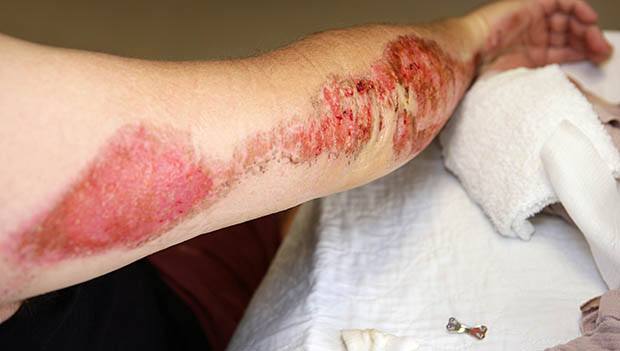
It's terrible, cringeworthy and downright painful, but let's face it—road rash is as synonymous with cycling as the yellow jersey itself. We do all we can to prevent torn Lycra and bloodied knees and elbows, but sometimes the inevitable happens. Gravity always wins.
Let's say you can't keep the rubber side down; what next? Since we're cyclists and writers and not doctors, we want to preface this article with a disclaimer:
Always seek help and advice from medical professionals. If you find yourself in a life-threatening emergency, call 911.
Now that we've gotten the dirty work out of the way, here is our best road rash treatment advice that we hope you never need to use.
Determine the Severity
If the cuts or scrapes are more than a quarter-inch deep and you can see fat, muscle or bone, head directly to the ER or urgent care for staples or stitches. If the wounds look like they're just on the surface of your skin, you can address the issue yourself (heading to the ER for scrapes and road rash can be expensive) using the steps outlined below.
If you're unsure and the bleeding won't stop, it's always best to err on the side of caution and have a doctor check it out.
Cleaning/Washing
It's likely you're in a remote area without support (or have to wait some time for someone to pick you up), so immediately spray your wounds with clean water from your water bottle to remove dirt and debris. Once home, thoroughly wash your hands and use soap to gently wash the wound.
Despite contrary belief, hydrogen peroxide or alcohol is not needed to clean a wound; it can actually irritate the tissue.
Stop the Bleeding
Most road rashes stop bleeding and scab up on their own after a while. If this hasn't happened after a couple days, apply sterile gauze to the area and apply even, consistent pressure. Apply more layers if the wound bleeds through the gauze, and don't remove the gauze to look at the wound—this can reopen the scab.
Dress the Wound
While some people decide to leave the area uncovered if the wound doesn't touch their clothes, you can help prevent infection by applying a thin layer of antibiotic ointment and covering the wound. This prevents the wound from drying out and can help prevent scaring.
Common dressings include bandages (for smaller wounds) or gauze pads and tape (for larger wounds). It's best to change the dressing on a daily basis, and whenever the wound bleeds or oozes through.
Monitor the Wound
Discoloration and scabbing can be normal, but keep your eyes open for signs of infection. These signs include redness and swelling, excess puss, red streaks leading away from the wound or a fever.
If any of these symptoms are present, contact your doctor. Again, it's always better to err on the side of caution.
Prevent Scarring
Some cyclists see road rash scars as badges of honor, but for those of us who aren't interested in a discolored tattoo shaped like Antarctica, there are ways to reduce scarring. First, listen to your mom—do not pick the scab, no matter how badly it itches. The scab will fall off on its own once the skin underneath is healed.
Next, keep the wound moist and clean by applying an antibiotic ointment at first, then a moisturizing cream once scabbed over. Lastly, keep the vulnerable area covered or use sunscreen with SPF 30+ to limit sun exposure. UV rays can darken the affected tissue and make them permanently discolored.
READ THIS NEXT: How to Handle a Bike Accident With a Vehicle










Discuss This Article